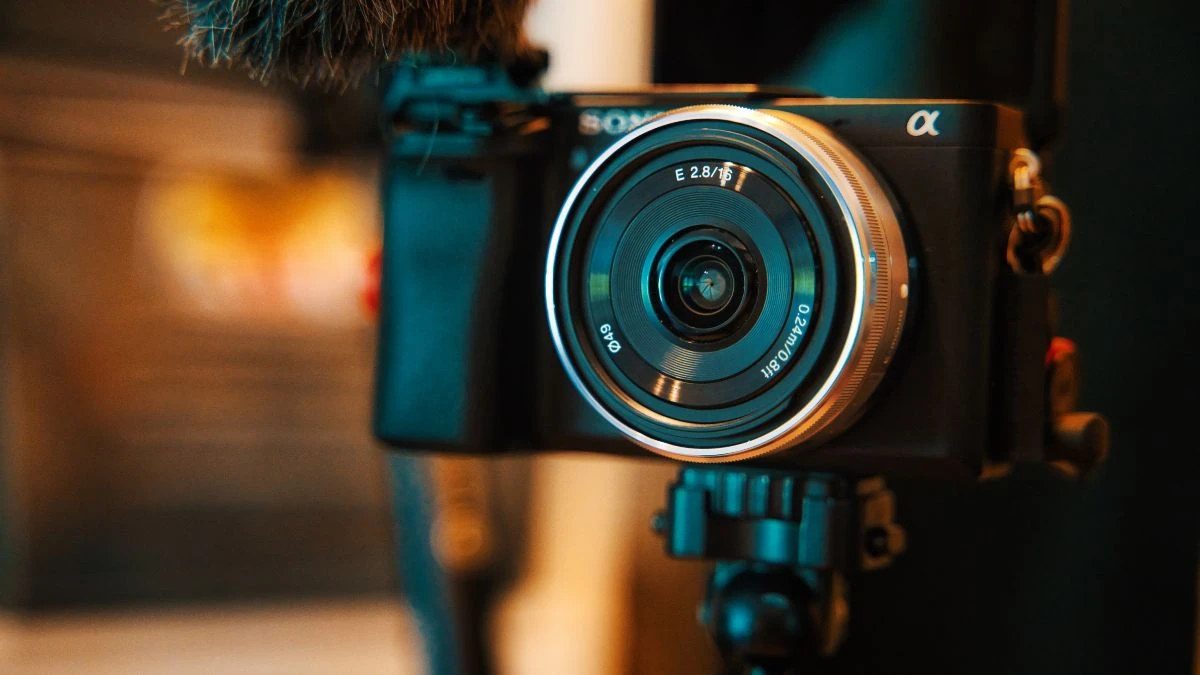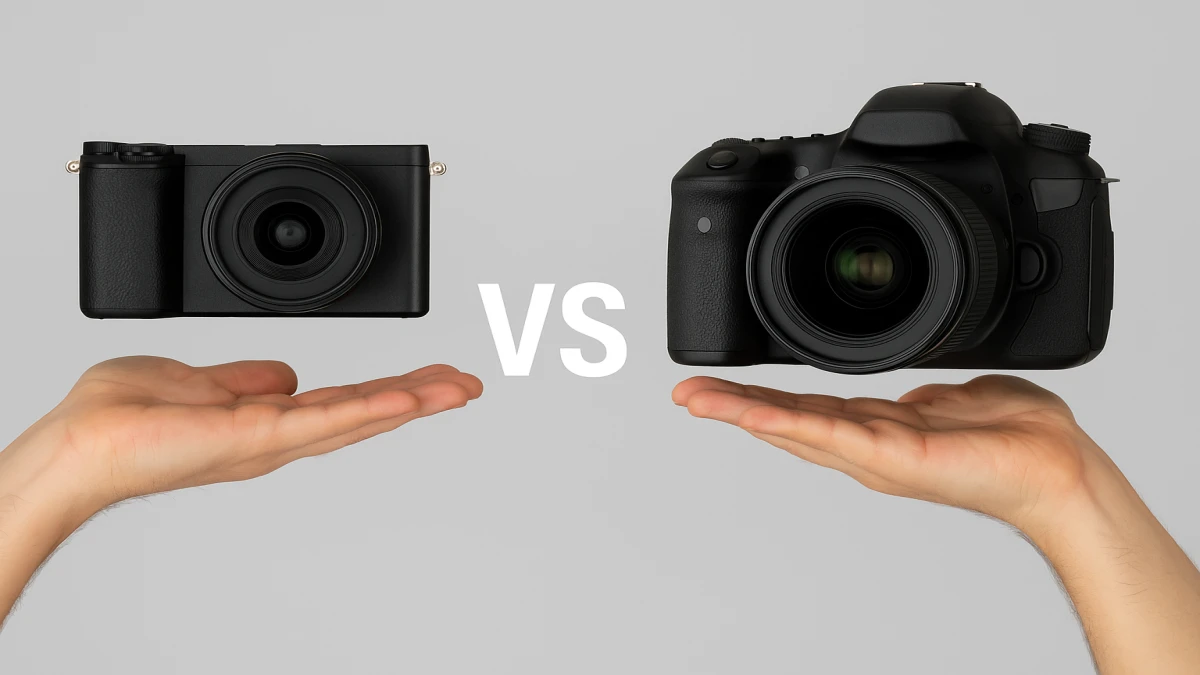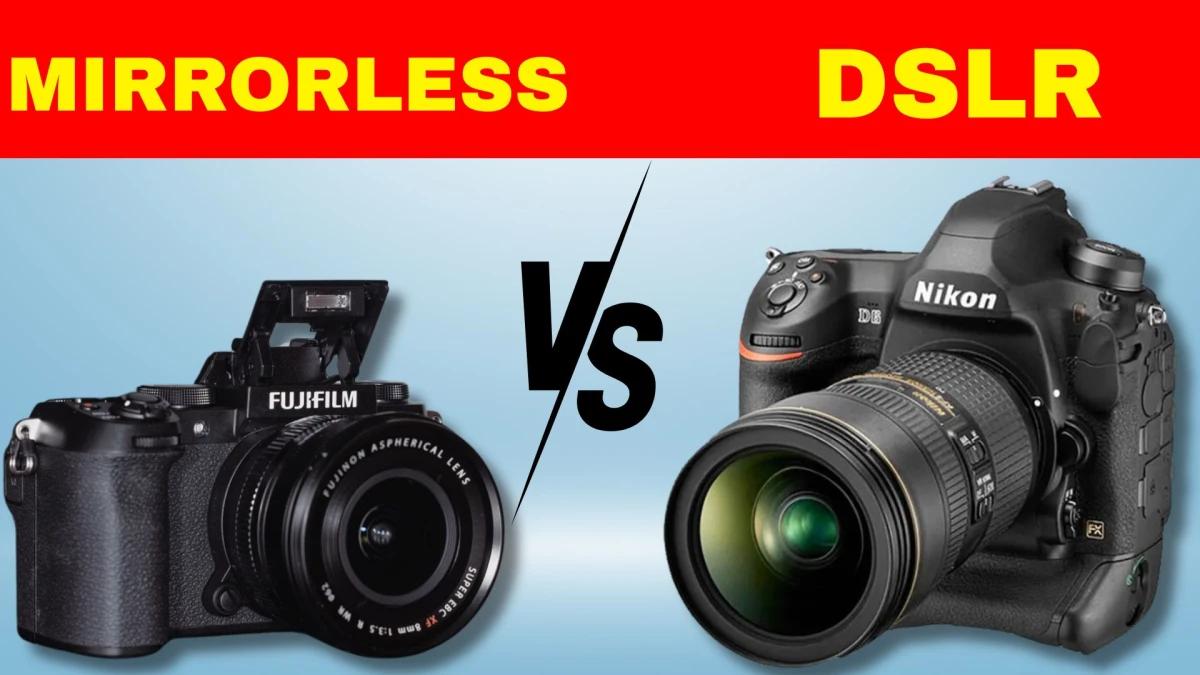Picture this: You're standing in a camera store, eyes darting between sleek, compact mirrorless cameras and the robust, professional-looking DSLRs.
Your photography journey is about to begin, but which path should you take? The difference between DSLR and mirrorless cameras has never been more important to understand, especially as technology continues to evolve at breakneck speed.
Whether you're a beginner looking to upgrade from smartphone photography or a seasoned shooter considering a system switch, this guide will illuminate the mirror vs mirrorless camera debate and help you make an informed decision.
What is a DSLR Camera?

DSLR (Digital Single-Lens Reflex) cameras have been the workhorses of professional photography for decades. But what is DSLR camera technology exactly?
At its heart, a DSLR contains a clever mirror mechanism that reflects light entering through the lens up into an optical viewfinder.
When you press the shutter button, this mirror flips up, allowing light to hit the image sensor instead. This mechanical process is what creates that satisfying "click" sound photographers have come to love.
The advantages of this design include:
- Optical viewfinders that show you exactly what you're shooting with zero lag
- Excellent battery life (often 800-1500 shots per charge)
- Robust build quality designed to withstand harsh environments
- A vast ecosystem of native lenses spanning decades of production
What is a Mirrorless Camera?

As the name suggests, what is a mirrorless camera comes down to one key distinction: it eliminates the mirror mechanism entirely. Instead, light passes directly through the lens to the image sensor, which provides a digital preview on either the rear LCD screen or an electronic viewfinder (EVF).
This fundamental design difference creates several advantages:
- Significantly smaller and lighter camera bodies
- Silent shooting options (no mirror slap)
- Real-time exposure preview through the EVF
- Advanced video capabilities with features like focus peaking and zebra patterns
- Faster continuous shooting speeds
What is the Differences Between DSLR and Mirrorless?
Understanding the difference between DSLR and mirrorless cameras requires looking at several important factors:
Size and Weight
The most obvious difference between DSLR and mirrorless camera systems is their physical dimensions.
Without the mirror box and pentaprism, mirrorless cameras can be dramatically smaller and lighter—sometimes half the weight of their DSLR counterparts.
For travel photographers and street shooters, this difference alone might be decisive. Imagine hiking the Appalachian Trail with a full-frame DSLR versus a comparable mirrorless system—your shoulders will certainly notice the difference after a few miles.

Autofocus Performance
- On-sensor phase detection covering nearly the entire frame
- Eye/face detection that works in real-time
- Subject recognition and tracking (humans, animals, vehicles)
- More focus points (often 700+ vs 50-100 on most DSLRs)
DSLRs still maintain one advantage: they typically perform better in extremely low light without assistance.
Viewfinder Experience
What is the difference between DSLR and mirrorless viewfinders? This is perhaps the most subjective area of comparison.
DSLR optical viewfinders show you the scene exactly as it is, with no digital interpretation or lag. Many photographers, particularly those who started in the film era, prefer this direct connection to their subject.
Mirrorless electronic viewfinders offer:
- WYSIWYG (what you see is what you get) exposure preview
- 100% frame coverage (some entry-level DSLRs only show 95%)
- Digital overlays like histograms, focus peaking, and level indicators
- The ability to review images without taking your eye away from the viewfinder
Battery Life
Here's where DSLRs maintain a clear advantage. Because mirrorless cameras must power an electronic viewfinder or LCD screen constantly, their battery life is typically 2-3 times shorter than comparable DSLRs.
A professional DSLR might capture 1,500+ images on a single charge, while even the best mirrorless cameras often tap out around 500-700 shots.
For day-long shoots without access to charging, this difference between DSLR and mirrorless could mean carrying several extra batteries.
Lens Selection
When considering what is the difference between DSLR and mirrorless, lens availability can be crucial depending on your photography needs.
Established DSLR systems from Canon and Nikon offer hundreds of native lenses spanning 50+ years of production. However, mirrorless lens libraries have expanded rapidly, with manufacturers creating innovative designs that weren't possible with DSLR mount limitations.
Many photographers bridge this gap with adapters, allowing DSLR lenses to work on mirrorless bodies—though sometimes with limited functionality.
Who Should Buy a DSLR Camera?
Despite the industry's clear shift toward mirrorless, DSLRs remain excellent tools for specific photographers:
- Sports and wildlife photographers who value optical viewfinders with zero lag
- Professionals with extensive investments in DSLR lenses
- Photographers who shoot in extreme conditions where battery life is critical
- Budget-conscious buyers (the used DSLR market offers incredible value)
- Those who prefer the ergonomics and handling of larger camera bodies
Who Should Buy a Mirrorless Camera?
The mirror vs mirrorless camera decision leans toward mirrorless for:
- Video creators who need advanced features like focus peaking and in-body stabilization
- Travel photographers prioritizing compact, lightweight gear
- Street photographers who value silent shooting
- Tech enthusiasts who appreciate the latest innovations
- Newcomers to photography without existing lens investments
| Feature | DSLR ✅ | Mirrorless ✅ |
|---|---|---|
| Size & Weight | ❌ Bulky | ✅ Lightweight |
| Battery Life | ✅ Long-lasting | ❌ Shorter (but improving) |
| Viewfinder | ✅ Optical (real scene view) | ✅ EVF with live preview |
| Autofocus | ❌ Limited in older models | ✅ Advanced AI autofocus |
| Lens Availability | ✅ Huge legacy options | ✅ Growing modern selection |
| Video Capabilities | ❌ Limited | ✅ Superior features |
| Learning Curve | ✅ More tactile | ✅ Beginner-friendly interface |
Hybrid Shooters: Can You Use Both?
Absolutely. Many photographers today identify as hybrid shooters, meaning they use both DSLR and mirrorless systems depending on the situation.
This is especially common among professionals who already own a collection of DSLR gear but want to take advantage of the compact form and cutting-edge features offered by mirrorless cameras.
Using both systems can provide flexibility:
- DSLRs might be your go-to for long outdoor sessions, sports, or wildlife photography where battery life and rugged durability are critical.
- Mirrorless cameras can shine in video production, travel, and street photography where portability and silent shooting are major advantages.
Adapters can bridge the gap by allowing DSLR lenses to be used on mirrorless bodies.
While performance may vary slightly (particularly autofocus speed), many adapters from brands like Canon, Nikon, and Sigma offer near-native performance.
For hybrid shooters, this means there's no need to start over—your existing lens investments can still pay off.
In-Body Image Stabilization (IBIS) vs. Lens-Based Stabilization
Image stabilization helps reduce blur caused by camera shake, especially at slow shutter speeds or when using telephoto lenses. In 2025, you’ll typically find two main types:
Lens-Based Stabilization (Optical IS/OIS):
- Built into the lens itself.
- Moves lens elements to counteract movement.
- Common in DSLR lenses and older systems.
- Especially effective in telephoto lenses where even small shakes are exaggerated.
- Available across both DSLR and mirrorless lenses.
In-Body Image Stabilization (IBIS):
- Found mainly in mirrorless cameras.
- Stabilizes the sensor directly by shifting it to compensate for movement.
- Works with any lens—even old manual lenses.
- Can be combined with lens-based stabilization for dual IS performance.
- Ideal for handheld video, low-light shooting, and adapting vintage glass.
Modern mirrorless cameras from brands like Sony, Canon, Nikon, Panasonic, and Fujifilm now include powerful 5-axis IBIS systems that rival or surpass lens-only stabilization.
For creators shooting both stills and video, IBIS is a major advantage.
AI and Computational Photography in Mirrorless Cameras
One of the biggest advantages of modern mirrorless cameras is their integration of AI-driven features and computational photography—something that's hard to match in traditional DSLRs.
Mirrorless systems often include:
- AI Autofocus that recognizes and tracks eyes, faces, animals, vehicles, and even birds in flight with high precision.
- Subject recognition trained on deep learning models, enabling better real-time tracking across the frame.
- Auto composition suggestions, scene detection, and smart exposure adjustments.
- Multi-frame noise reduction and HDR blending for better image quality straight out of the camera.
- Focus bracketing, stacking, and depth compositing for macro and landscape photography—all done in-camera.
As computational photography from smartphones continues to influence camera design, mirrorless models are embracing intelligent features to make photography faster, easier, and more accessible—without sacrificing quality.
This is particularly appealing to content creators, vloggers, and anyone wanting top-tier results with minimal post-processing.
Conclusion: Mirrorless vs DSLR – Which One Wins?
In 2025, the choice between DSLR and mirrorless cameras is less about which system is objectively better and more about what works best for your unique photography needs.
DSLRs continue to offer unmatched battery life, robust build quality, and a massive selection of native lenses—making them an excellent choice for traditionalists, budget-conscious shooters, and professionals invested in legacy gear.
On the other hand, mirrorless cameras represent the cutting edge of photography, delivering compact bodies, advanced autofocus, real-time exposure previews, and powerful video capabilities.
With rapid innovations in AI autofocus, in-body image stabilization, and computational photography, mirrorless systems are fast becoming the new industry standard.
Ultimately, both systems are capable of producing stunning images and videos. The right camera is the one that complements your workflow, inspires creativity, and feels right in your hands.
Whether you choose the time-tested reliability of a DSLR or the future-ready features of a mirrorless camera, what matters most is getting out there and capturing the moments that matter to you.






